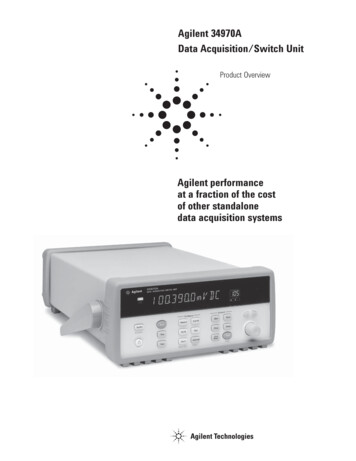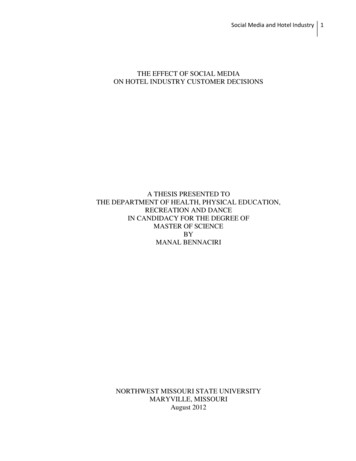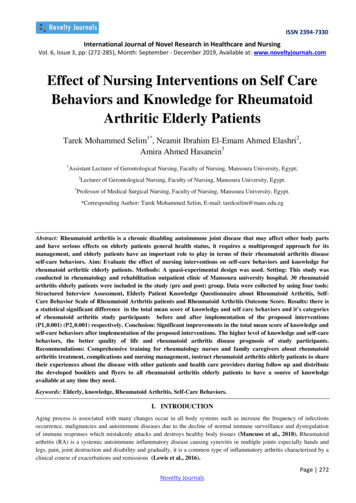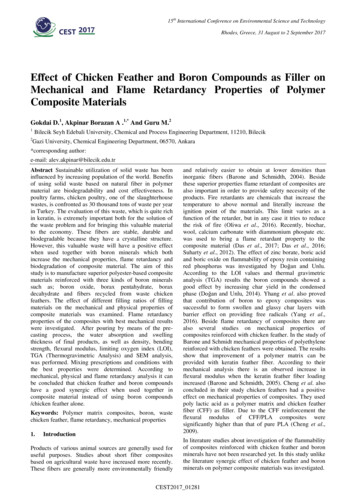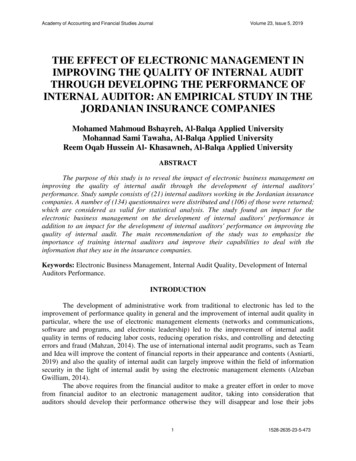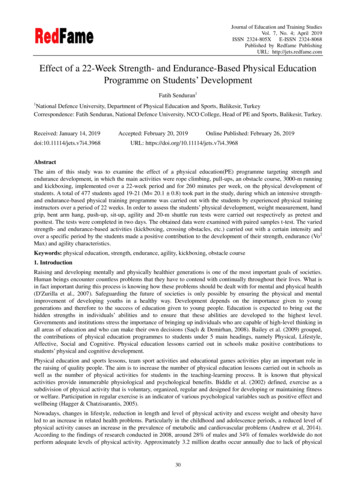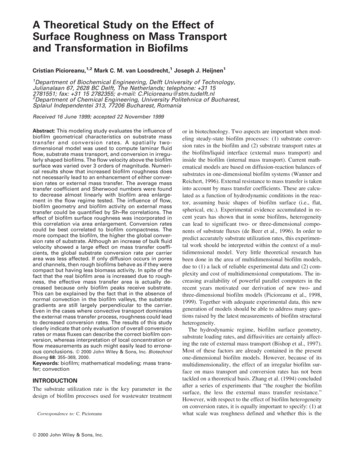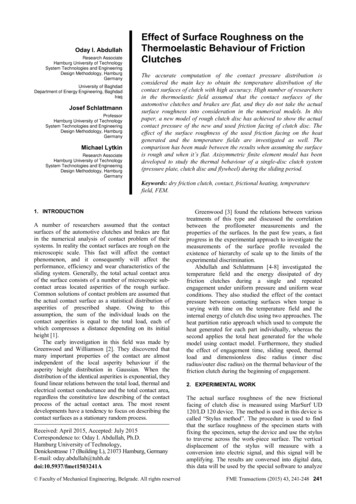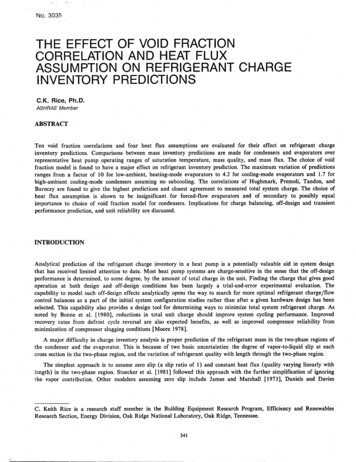
Transcription
No. 3035THE EFFECT OF VOID FRACTIONCORRELATION AND HEAT FLUXASSUMPTION ON REFRIGERANT CHARGEINVENTORY PREDICTIONSC.K. Rice, Ph.D.ASHRAEMemberABSTRACTTen void fraction correlations and four heat flux assumptions are evaluated for their effect on refrigerant chargeinventory predictions. Comparisons between mass inventory predictions are made for condensers and evaporators overrepresentative heat pump operating ranges of saturation temperature, mass quality, and mass flux. The choice of voidfraction model is found to have a major effect on refrigerant inventory prediction. The maximum variation of predictionsranges from a factor of 10 for low-ambient, heating-mode evaporators to 4.2 for cooling-mode evaporators and 1.7 forhigh-ambient cooling-mode condensers assuming no subcooling. The correlations of Hughmark, Premoli, Tandon, andBaroczy are found to give the highest predictions and closest agreement to measuredtotal system charge. The choice ofheat flux assumption is shown to be insignificant for forced-flow evaporators and of secondary to possibly equalimportance to choice of void fraction model for condensers. Implications for charge balancing, off-design and transientperformance prediction, and unit reliability are discussed.INTRODUCTIONAnalytical prediction of the refrigerant charge inventory in a heat pump is a potentially valuable aid in system designthat has received limited attention to date. Most heat pump systems are charge-sensitivein the sensethat the off-designperformance is determined, to some degree, by the amount of total charge in the unit. Finding the charge that gives goodoperation at both design and off-design conditions has been largely a trial-and-error experimental evaluation. Thecapability to model such off-design effects analytically opens the way to search for more optimal refrigerant charge/flowcontrol balances as a part of the initial system configuration studies rather than after a given hardware design has beenselected. This capability also provides a design tool for determining ways to minimize total system refrigerant charge. Asnoted by Bonne et al. [ 19801, reductions in total unit charge should improve system cycling performance. Improvedrecovery rates from defrost cycle reversal are also expected benefits, as well as improved compressor reliability fromminimization of compressorslugging conditions [Moore 19781.A major difficulty in charge inventory analysis is proper prediction of the refrigerant mass in the two-phase regions ofthe condenser and the evaporator. This is because of two basic uncertainties: the degree of vapor-to-liquid slip at eachcross section in the two-phase region, and the variation of refrigerant quality with length through the two-phase region.The simplest approach is to assumezero slip (a slip ratio of 1) and constant heat flux (quality varying linearly withlength) in the two-phase region. Stoecker et al. [ 198l] followed this approach with the further simplification of ignoringthe vapor contribution. Other modelers assuming zero slip include James and Marshall [ 19731, Daniels and Davies-C. Keith Rice is a research staff member in the Building Equipment Research Program, Efficiency and RenewablesResearch Section, Energy Division, Oak Ridge National Laboratory, Oak Ridge, Tennessee.341
[1975], Dhar and Soedel [ 19791, Bonne et al. [ 1980; *], Farr, and MacArthur [ 19841. These investigators used avariety of constant and discretely variable heat flux approaches in their heat exchanger analyses. Other researchers[Otaki 1973; Otaki and Yoshii 1975; Rigot 1973; Ahrens 19831 have included slip effects but assumed constant heatflux. Domanski and Didion [ 19831 included slip effects and computed the two-phase region in a tube-by-tube manner,thus having discretely varying heat flux. Only Domanski and Otaki included comparisonsof analytical charge inventoryresults to experiment. Domanski found significant differences in both condenser and total inventory comparisons, whileOtaki’s results were generally within 10% of measured total charge for a variety of vapor compressionmachines. The major emphasis of this paper is to survey and compare a wide variety of slip ratio models (more generallyrepresented by void fraction correlations) and four, different heat flux variation assumptions. Both void fractioncorrelations developed for annular flow and those proposed as reasonably accurate without regard to flow regime areincluded. A brief review of each correlation from the author’s perspective is provided followed by comparisons of theirpredictions for casesof direct application to heat pump charge inventory analysis. This is done with regard to the effecton refrigerant mass predictions over the two-phase region of condensers and evaporators operating at representativeconditions.The basic equations for charge inventory calculation are given first for both single-phaseand two-phase regions of aheat exchanger. The relationship of void fraction correlation and heat flux assumption to these equations is developedhere. The various void fraction correlations to be considered are presented next along with sample predicted profiles vs.mass quality. The specifics of the four considered heat flux assumptions are then developed followed by total two-phasemass inventory predictions for the various correlations for a constant heat flux. The effect of variable heat flux on thepredictions is examined and compared to the influence of void fraction correlation. The results are compared withavailable charge inventory measurements.Last, possible implications of the range of predictions and applications of theresults are discussedwith regard to systemcharge inventory control and off-design and transient performance prediction.BASIC EQUATIONSSingle-Phase Refrigerant SectionsThe single-phase refrigerant mass,m, contained in a length of tubing, L, of cross-sectionalarea A, and total volume,V is given by(1)where p is the local single-phase refrigerant density along the tube. Equation 1 can be rewritten aswhere payeis a suitably averaged* refrigerant density over the tube length. These equations would be used to calculatethe refrigerant mass in the subcooledliquid or superheatedvapor sections of a heat exchanger.l UlrichBonne, Honeywell, Inc., Corporate Technology Center, Bloomington, MN, personal communication, 1982. Richard A. Farr, R&R Supply Company, Inc., Columbus, OH, personal communication, 1983.*The choice of averaging method used for nonisothermal single-phase regions is of secondary importance when comparedto the uncertainties in the two-phasecalculations.342
Two-Phase Refrigerant SectionsThe two-phase refrigerant mass contained in a length of tubing is obtained by summing the gas g and liquid fcontributions occupying each cross-sectional area over the length of the region. These contributions are given separatelyby:mg s,L Pg’ dVg PgsoLAg.dl(2),and(3)whereA,Af4 cross-sectionalarea occupied by vapor, cross-sectional area occupied by liquid, and A, -I- AJ at each cross section.Relationship to Void FractionIntroducing the void fraction CY A,/A,, Equations 2 and 3 can be rewritten as:“g(4) ,ogAcjoL a.dZ ,and“2/ p,A,JbL(l-a).dl(5).The total mass,mr, in the two-phase section can be obtained from Equations 4 and 5 in terms of tube volume V as:Density Weighting FactorsThe void fraction (Yis generalIy representedas some function of refrigerant quality, x. Therefore, to evaluate m1 fromEquation 6 for a given void fraction equation, i.e.,CY f,(x)(7)9the tube length variable, 1, must be related to mass quality, x, in some manner. This relationship is obtained from anassumption regarding the heat flow variation, dQ, with differential length, dl, in the two-phaseregion, that is,dQ I;zrhjgdx fe(x).dl,(8)wherem, refrigerant massflow rate,hrg enthalpy of vaporization, andfe(x) assumedheat flux equation (i.e., equation for local heat flow per differential length*).*Because the heat flow per differential length is functionally equivalent to the heat flux dependencein a tube assumingno radial dependence,heat j7ux variation will be used herein instead of local heat flow per unit length.343
In terms of the representationsfoL(x) and fe(x)m, v*IPgWg P/O-wg given by Equations 7 and 8, Equation 6 can be rewritten as:1(947wherew JX:fJxVf (x)dxC’b)gj-XT l/fe(xMx’and xi and x, are inlet and outlet refrigerant qualities. The normalized integral Wg is the refrigerant gas densityweighting factor.* Thus the evaluation of the two-phase refrigerant mass is reduced to the problem of evaluating theintegrals given in Equation 9b for selectedvoid fraction correlations [f Jx ))s] and heat flux assumptions[ fe(x ))s].Since the refrigerant liquid term is the major contributor to the total mass in the heat exchanger, it is convenient fordiscussion purposesto rewrite Equations 9a and 9b in terms of the refrigerant liquid density weighting factor, WI, i.e.,(1041mi v 1PfWf PgO - Wf ,whereJ,“fdx)/fe(x)dx(lob)Wf j-%- l/fQ(x)dx’and f rWa(x) 1 - f,(x) liquid fraction (or holdup) correlation.Equation 9a or 10a thus gives the total refrigerant massin the two-phase section of a heat exchanger.VOID FRACTION REPRESENTATIONSThe void fraction is generally represented as a function of mass quality, x, and combinations of various types of propertyindexes (which remain constant for a given average evaporator or condenser saturation temperature). Only in a few caseshave dependenceson mass flow rate been correlated. Existing correlations reviewed by the author were classified intofour correlated, andmass-flux-dependent.HomogeneousThe homogeneous model is the most simplified. The model considers the two phases as a homogeneous mixture,thereby traveling at the same velocity. In this model, the relationship between void fraction, 01,and mass quality, x, isstraightforwardly derived as:1a 1 -‘”Il(11)tP.Z.,IWg can alternatively be described as the heat-flux-averaged void fraction over a given massquality range.344
where the property index P.Z., pg/pJ. This formulation has been used by James [1973], Daniels [ 19751, Dhar[ 19791,Stoecker [ 19811,Bonne [ 19801,and MacArthur [ 19841.Slip-Ratio-CorrelatedA slightly more involved approach is to assumethat the liquid and vapor phases are separated into two streams thatflow through the tubes with different velocities, ug and uf, the ratio of which is given by the slip ratio S ug/up Amodified form of Equation 11 has been used to include this effect, i.e.,1a 1 l-xPgs--.I1eDX1 l--xX[I prt(12)P.Z.1.SIwhere S is estimated differently by various investigators.Rigot and Ahrens/Thom. Rigot [ 1973) suggested using an average value of 2 for slip ratio for his intendedapplication. Ahrens [ 19831 recommended use of the steam/water data of Thorn [ 19641 suitably generalized by theproperty index P.Z.2 given by:(13)In the Ahrens/Thom method, the slip ratio, S, is, in effect, dependent on the refrigerant operating pressure only and isthus independent of quality. The Thorn method was developed along the same lines as the more well known MartinelliNelson [ 19481 approach for steam/water systems under boiling conditions. The Thorn method represents a moreextensive set of void fraction data and as such should be the preferred choice. Slip ratio values generalized from theThorn method in terms of P.Z. 2are given in Table 1. In Table 2, corresponding values of various property ratiosaregivenforanappropriaterange of R-22 saturation temperatures. From Tables 1 and 2, it can be seenincluding *-’P.Z.z .----‘-thatin the Thorn method, the &a ratio is predicted to range.from- about 1.5 at high condensing temperatures to about2.5 at low evaporatemgtemperatures.Zivi. Zivi [ 19641developed a void fraction equation similar in form to Equation 12 where S is given by:s IP.Z., -If3 .1(14)This relationship was developed for annular flow based on principles of minimum entropy production under conditions ofzero wall friction and zero liquid entrainment (100% liquid entrainment gives a slip ratio of 1).Smith. Smith [1969] developed a correlation based on equal velocity heads of a homogeneousmixture center and anannular liquid phase. He obtained an equation for slip ratio S, dependent on the density ratio P.Z.l, mass quality, andentrainment ratio K given by:*l/PJ1 KS K (1 -K)wk-4l-xx(15)and where K 0.4 was found to correlate well with the three setsof experimental data considered.In summary, the slip-ratio-correlated equations all use Equation 12 for void fraction with the vapor slip ratio S givenalternatively bys 2,Rigot [ 19731,*Zivi also developedmore involved slip equations dependent on entrainment level and mass quality but did not attempt ageneral correlation to existing data.345
S f(P.Z.2) in Table I,Ahrens/Thom [ 19831,s (P.Z.J-‘i3,Zivi [ 19641,S f(P.1. r, x), Equation 15,Smith [ 19691.ororX,-CorrelatedAnother group of correlations avoids the use of a form of the homogeneous equation by employing the LockhartMartinelli (L-M) correlating parameter X,, defined as:1- x o.9I x I P.I.p&t .(16)The well-known early L-M pressure drop work [ 19491 presented void fraction data as a functionLockhart-Martinelli.of X,, on two-phase/two-component adiabatic flows near atmospheric conditions. These data were approximated byequations developedby Wallis [ 19691and refined by Domanski and Didion [ 19831for X,, 10. The equations are: cl xl10.8)-0.378 0.823 -0.157 In X,,for X,, 10 ,(17)for X,, 10 .(18)These equations were used by Domanski [ 19831in a charge inventory model for heat pump simulation.Baroczy. A second general X,, correlation is that developed by Baroczy [ 196.51.He added a direct functionalbeyond that already included in the L-M correlatingdependenceon the property index P.I. 2, i.e., (Y f(X,,,P.Z.¶meter, Xtt, as given by Equation 16. This correlation was developed over a wider range of conditions than the L-Mrepresentation and li
The simplest approach is to assume zero slip (a slip ratio of 1) and constant heat flux (quality varying linearly with length) in the two-phase region. Stoecker et al. [ 198 l] followed this approach with the further simplification of ignoring the vapor contribution. Other modelers assuming zero slip include James and Marshall [ 19731, Daniels and Davies - C. Keith Rice is a research staff .
